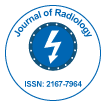Effect of Food Intake on Intravoxel Incoherent Motion and T2* in the Healthy Liver
Received Date: Nov 26, 2017 / Accepted Date: Dec 04, 2017 / Published Date: Dec 11, 2017
Abstract
Introduction: To evaluate the effect of increasing portal flow due to food intake on the parameters of Intravoxel Incoherent Motion (IVIM) and T2* relaxation time in healthy liver.
Materials and methods: The subjects consisted of 15 healthy volunteers. We used a 1.5 T MRI system. All subjects received MRI three times as follows: after overnight fasting but before food intake, at 30 min, and at 4 h after food intake. MRI was repeated at a greater than 1 week interval. All subjects had 800 kcal of Calorie Mate. The echoplanar diffusion-weighted imaging was performed under free breathing and 10 b-values (0, 10, 20, 30, 50, 80, 100, 200, 400, 800 s/mm2) were obtained. T2*-weighted imaging with multi-echo gradient-echo sequence was performed with Siemens MapIt software under breath-holding. The portal flow measurement was performed with phase contrast sequence. The parameters of IVIM including ADC, DC, D*, and PF were calculated and T2* relaxation time was obtained using MapIt.
Results: The portal blood flow increased significantly 30 min after food intake (P<0.0001). The ADC, DC, D*, PF and T2* values after overnight fasting, at 30 min, and at 4 h after food intake showed no significant differences after food intake.
Conclusion: Increasing portal venous flow after food intake does not affect IVIM parameters and T2* of liver parenchyma in healthy volunteers.
Keywords: Liver; Intravoxel incoherent motion; Food intake; Diffusion weighted imaging
Citation: Shimizu T, Saito K, Shirota N, Harada TL, Tajima Y, et al. (2017) Effect of Food Intake on Intravoxel Incoherent Motion and T2* in the Healthy Liver. OMICS J Radiol 6: 285. Doi: 10.4172/2167-7964.1000285
Copyright: ©2017 Shimizu T, et al. This is an open-access article distributed under the terms of the Creative Commons Attribution License, which permits unrestricted use, distribution, and reproduction in any medium, provided the original author and source are credited.
